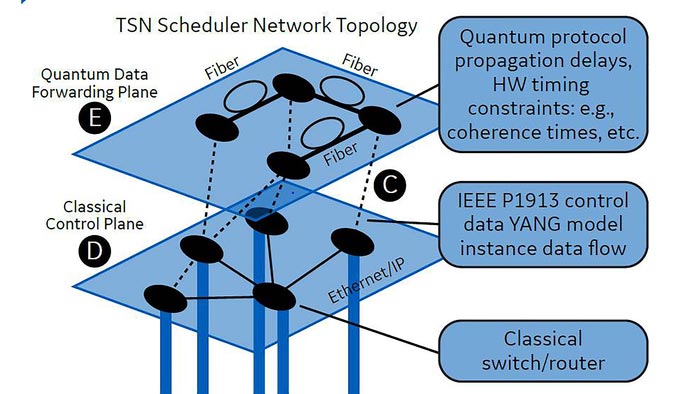Quantum networks in our future

Control mechanism for proposed quantum network
Credit: Stephen F. Bush
To develop quantum networks, the unique needs of industry must be considered and may provide a solution.
Large-scale quantum networks have been proposed, but so far, they do not exist. Some components of what would make up such networks are being studied, but the control mechanism for such a large-scale network has not been developed. In AVS Quantum Science, by AIP Publishing, investigators outline how a time-sensitive network control plane could be a key component of a workable quantum network.
Quantum networks are similar to classical networks. Information travels through them, providing a means of communication between devices and over distances. Quantum networks move quantum bits of information, called qubits, through the network.
These qubits are usually photons. Through the quantum phenomena of superposition and entanglement, they can transmit much more information than classical bits, which are limited to logical states of 0 and 1, are able to. Successful long-distance transmission of a qubit requires precise control and timing.
In addition to the well-understood requirements of transmission distance and data rate, for quantum networks to be useful in a real-world setting there are at least two other requirements of industry that need to be considered.
One is real-time network control, specifically time-sensitive networking. This control method, which takes network traffic into account, has been used successfully in other types of networks, such as Ethernet, to ensure messages are transmitted and received at precise times. This is precisely what is required to control quantum networks.
The second requirement is cost. Large-scale adoption of an industrial quantum network will only happen if costs can be significantly reduced. One way to accomplish cost reduction is with photonic integrated circuits.
“The value of quantum technologies in industry must be favorable before it will be adopted,” said author Stephen Bush. “In particular, a ‘quantum advantage’ must exist in which a quantum technology has the ability to outperform a classical technology (computing, communication, or sensing).”
So far, no quantum technology has demonstrated such an advantage, but scientists are working to develop benchmarks as they work toward this goal.
“The ability to scale the number of quantum network interconnections is an important requirement that must be addressed,” said Bush.
One application area of interest for quantum networks is cybersecurity. These applications can involve a method known as quantum key distribution, or QKD, in which two parties share a random secret key known only to them that can be used to encrypt and decrypt a message.
Use of QKD will, however, require standardization and certification, which is in the early stages.
“Government regulations enforcing the use of QKD cannot be enacted until consensus has been reached for how security is tested and certified by a trusted organization,” said Bush.
Despite the challenges that must be overcome, the authors believe the industry has the technological ability to build functioning quantum networks.
The article “A perspective on industrial quantum networks” is authored by Stephen F. Bush, William A. Challener, and Guillaume Mantelet. The article will appear in AVS Quantum Science on Aug. 31, 2021 (DOI: 10.1116/5.0051881). After that date, it can be accessed at https://aip.scitation.org/doi/10.1116/5.0051881.
ABOUT THE JOURNAL
AVS Quantum Science, co-published by AIP Publishing and AVS, is a truly interdisciplinary journal that reaches from its foundations in quantum science into a breadth of areas from condensed matter and atomic, molecular, and optical physics, to biology, chemistry, and materials science, as well as computer science and engineering. The journal places a strong emphasis on focused and comprehensive reviews and features perspectives and original research.
ABOUT AVS
AVS is an interdisciplinary, professional society with some 4,500 members worldwide. Founded in 1953, AVS hosts local and international meetings, publishes four journals, serves members through awards, training and career services programs, and supports networking among academic, industrial, government, and consulting professionals. Its members come from across the fields of chemistry, physics, biology, mathematics, engineering, and business and share a common interest in basic science, technology development and commercialization related to materials, interfaces, and processing. https://www.avs.org
Journal: AVS Quantum Science
DOI: 10.1116/5.0051881
Article Title: A perspective on industrial quantum networks
Article Publication Date: 31-Aug-2021
Media Contact
Larry Frum
media@aip.org
Office: 301-209-3090
All latest news from the category: Information Technology
Here you can find a summary of innovations in the fields of information and data processing and up-to-date developments on IT equipment and hardware.
This area covers topics such as IT services, IT architectures, IT management and telecommunications.
Newest articles

Innovative 3D printed scaffolds offer new hope for bone healing
Researchers at the Institute for Bioengineering of Catalonia have developed novel 3D printed PLA-CaP scaffolds that promote blood vessel formation, ensuring better healing and regeneration of bone tissue. Bone is…

The surprising role of gut infection in Alzheimer’s disease
ASU- and Banner Alzheimer’s Institute-led study implicates link between a common virus and the disease, which travels from the gut to the brain and may be a target for antiviral…

Molecular gardening: New enzymes discovered for protein modification pruning
How deubiquitinases USP53 and USP54 cleave long polyubiquitin chains and how the former is linked to liver disease in children. Deubiquitinases (DUBs) are enzymes used by cells to trim protein…



